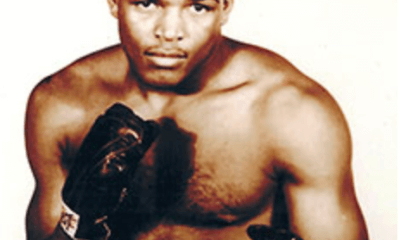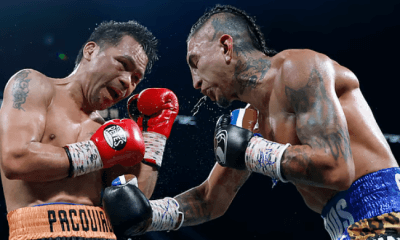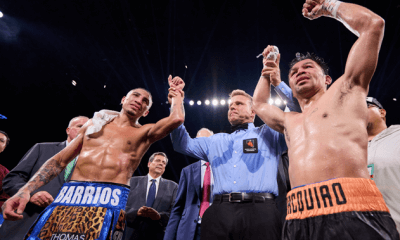Articles of 2009
A Fan’s Perspective On The Int'l Boxing Hall Of Fame
Interstate 90 in upstate New York is a tour of sports history with three halls of fame and two rich sports towns in Syracuse and Buffalo. The most highly-regarded of the three is the National Baseball Hall of Fame in Cooperstown. Opened in 1939, it houses a museum displaying a decade-by-decade history of the sport, a research library that is open to the public and a large, prestigious hall honoring its inductees. The National Soccer Hall of Fame is 25 miles to the south in Oneonta, and 70 miles to the northwest is the International Boxing Hall of Fame (IBHOF) in Canastota.
Canastota, a town with a population of about 4,300, became the site of the IBHOF as a result of the town’s residents’ fundraising efforts. Their work stemmed from the fact that Canastota has produced two champions, former welterweight and middleweight titleholder Carmen Basilio, and his nephew Billy Backus, who won the welterweight title in 1970. The IBHOF opened in 1989 and inducted its first class a year later. As the IBHOF website states, it “holds an annual induction ceremony in early June as the highlight of a four-day celebration of boxing and its legends.”
If you attend the induction ceremonies, you are likely to see the IBHOF at its best. This year’s induction, held the weekend of June 13, featured the usual parade of champions, story sessions from fighters, a gala and induction speeches from Lennox Lewis and Larry Merchant. A Who’s Who of boxing was in attendance, including Basilio, Emile Griffith, Marvelous Marvin Hagler, Aaron Pryor, Michael Carbajal, Carlos Palomino, Bert Sugar, Angelo Dundee and Emanuel Steward. It’s difficult to imagine mixing and mingling among such legends without feeling a unique energy or awe.
But let’s say you decide to pull off of exit 34 and check out the IBHOF after visiting Cooperstown on a Thursday in March. If you’ve been to other halls of fame before, you probably expect an ordered display on the history of pugilism. Instead, you enter what seems to be a modular building with two rooms and are told to stop by the adjacent warehouse before you leave.
To the left are the encased robes of former champions like Hagler and Ken Buchanan. You are told when you enter that fighters have been very generous in donating items to the IBHOF, and you appreciate their contributions. However, you can’t help but feel pity for the poor fighters whose robes have ended up on coat hangers on the wall, free for the public to touch or even try on if IBHOF staff isn’t looking. You wonder which would be more annoying to fighters, finding their robes in storage or displayed in the open on a coat hanger.
Turn to the right, and you’ll see stand-up displays of some the great heavyweights and their gloves. On the wall are pictures highlighting some of the great heavyweights, light heavyweights and middleweights. If the IBHOF chose to go the route of displaying great pictures fighters, it is uncertain why they did not choose to showcase all of the original eight divisions. In the adjoining room, various “The Ring” magazines and fight posters are displayed, most of which are of Muhammad Ali’s bouts. It makes you wonder if the IBHOF structured its museum based on its donations instead of vice-versa.
Two glass-cased displays will make you cringe. One contains only an assortment of mouthpieces from various fights. The other contains only hand wraps.
In the back is the actual hall, a cramped collection of plaques. Fans would be surprised to learn that the IBHOF has more inductees than baseball’s hall, despite being 50 years younger. Sadly it does not have the space or budget for all of them. Inductees are enshrined on plaques smaller than those found in most high school trophy cases. The claustrophobic space makes the clichéd statement that a fighter’s “place in Canastota is secure” seem ridiculous.
The hall has a separate warehouse, which serves as home to its memorabilia shop and Madison Square Garden’s old boxing ring, which framed the Garden’s fights from 1925 to 2007. The IBHOF has a staff that is extremely knowledgeable about boxing and can provide a colorful description of the ring’s 82-year history. However, given the fact that the ring is 20×20 feet, the wing has a great deal of space, most of which is unused.
The IBHOF should remedy this by moving the memorabilia shop into its main office and transferring its hall and displays to the warehouse. This would allow scrapping the jumbled displays of robes, mouthpieces and hand wraps for a fuller, structured display on the history of boxing. It would also give the IBHOF room to establish a hall that displays the inductees in an easier to follow manner.
No one, unless burdened with snobbery and unrealism, expects the IBHOF to be in the same league with baseball’s hall, but the current display fails to properly recognize boxing’s exemplary fighters and their legacies.
For more on the Hall, here's a recent story by George Kimball: https://www.tss.ib.tv/boxing-article/6918/kimball-chronicles-hall-fame-weekend/
-

 Featured Articles3 weeks ago
Featured Articles3 weeks agoResults and Recaps from New York Where Taylor Edged Serrano Once Again
-

 Featured Articles3 days ago
Featured Articles3 days agoThe Hauser Report: Zayas-Garcia, Pacquiao, Usyk, and the NYSAC
-

 Featured Articles3 weeks ago
Featured Articles3 weeks agoResults and Recaps from NYC where Hamzah Sheeraz was Spectacular
-

 Featured Articles3 weeks ago
Featured Articles3 weeks agoFrom a Sympathetic Figure to a Pariah: The Travails of Julio Cesar Chavez Jr
-

 Featured Articles3 weeks ago
Featured Articles3 weeks agoPhiladelphia Welterweight Gil Turner, a Phenom, Now Rests in an Unmarked Grave
-

 Featured Articles2 weeks ago
Featured Articles2 weeks agoManny Pacquiao and Mario Barrios Fight to a Draw; Fundora stops Tim Tszyu
-

 Featured Articles1 week ago
Featured Articles1 week agoArne’s Almanac: Pacquiao-Barrios Redux
-

 Featured Articles4 weeks ago
Featured Articles4 weeks agoCatterall vs Eubank Ends Prematurely; Catterall Wins a Technical Decision














